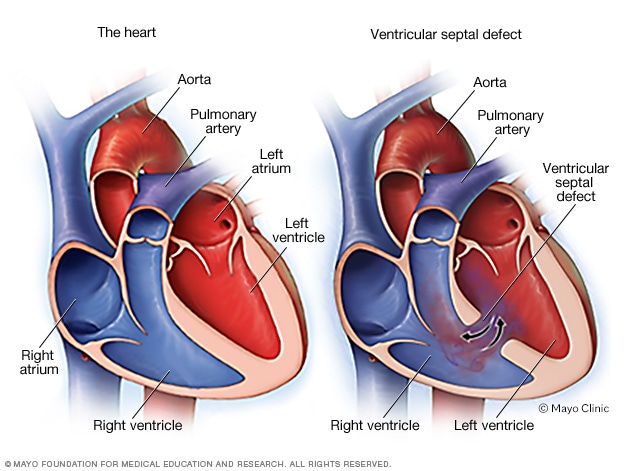Ventricular Septal Defect (VSD) – Types and Treatments
Ventricular Septal Defect (VSD) – Types and Treatments
What Is a Ventricular Septal Defect (VSD)?

Ventricular septal defect (VSD) is also known as the ventral septal defect, it is the situation in which there is a small gap or a hole between lower chambers or ventricles of your heart. It is also can be any defect that occurs in any part of your heart’s muscle which divides the two sides of the heart.
In most of the situation, the ventricular septal defect can be when there is a hole between the right and left chambers of the heart. As we all know that there are four chambers of the heart and they are like: a right and left upper chamber which is called atrium and a right and left lower chamber which is called a ventricle.
In a normal situation, the right and left chambers of our heart are separated from each other with inbuilt tissue wall which is called a septum. Likewise, the right atrium is apart from the left atrium by the tissue called atrial septum and the right ventricle is apart from the left ventricle by the ventricular septum.
As we have mentioned that VSD is that situation when hole finds between the chambers of the heart but it is normal with a newborn baby that it finds a small hole between two atria and which is automatically get filled within the two weeks of life.
In normal cases, there is no hole between the two ventricles, but in rare cases, infants are born with this kind of holes between ventricles and that is called ventricular septal defects.
(VSD) Ventricular septal defects are one of the most common congenital heart diseases, which occurs in 0.1& to 0.4% in all newborn babies. Also, ventricular septal defects are one of the most common cause for letting newborn to the cardiologist for treatment. Don’t forget to consult expert pediatric cardiologist for VSD Treatments.
Types of Ventricular Septal Defect: –
This is not an ordinary disease and as well it has its own types. There are four types of Ventricular Septal Defect and slightly they all are different from each other.
Membranous Ventricular Septal Defect: – It is the first type of VSD and this is the situation when there is a hole in the upper section of the ventricular septum situated in front aortic and tricuspid valves of the heart. This is worst kind of VSD because usually, it doesn’t close by itself and surgery is often needed.
Muscular Ventricular Septal Defect: – It is the VSD in which hole present in the opening of the muscular area of the lower part of the ventricular septum. In the cases of Muscular Ventricular Septal Defect most probably of these repairs automatically and do not require surgery or operation.
Atrioventricular Ventricular Septal Defect: – This type of VSD happens with the atrioventricular canal defect. The VSD occurs just beside to the tricuspid and mitral valves. And in this kind of cases, surgery must be required.
Conal septal VSD: – This one is the rarest type of VSD which occurs in the ventricular septum under the pulmonary valve.
Symptoms of Ventricular Septal Defect: –

IF you aware with the symptoms of Ventricular Septal Defect then it is fine, but if you don’t aware but concern about it then you should know the symptoms that you may feel and then treat your newborn baby. Ventricular septal defect (VSD) symptoms may include:
It is one of the first sign you may see but you have to feel or notice this that your newborn baby is eating properly or not. Poor eating can be the sign of Ventricular Septal Defect.
- You may notice your baby to breath faster as compare to the normal breathing capacity, this is the second sign of Ventricular Septal Defect.
- Your baby may feel tire most of the time after playing for very little time.
- It is very common that you and your specialist may not able to see any signs of a ventricular septal defect in the starting of birth. If Ventricular Septal Defect is small, then takes time to appear until later in childhood. Symptoms and signs of Ventricular Septal Defect highly dependent upon the density of the defect and hole in the heart.
- Another way to check this is that when you take you’re newborn to your doctor then he or she may notice during a regular checkup if they hear sound like “murmur” during the breathing of your baby. We suggest you to always check it by ultrasound before the baby is born then it will become quite easy to repair it.
Treatment Of Ventricular Septal Defect: –
In some kind of cases, it becomes quite necessary to go for surgery, surgery for ventricular septal defects comprise fixing the irregular opening between the ventricles. On the off chance that you or your baby is having a medical procedure to fix a ventricular deformity, consider having a medical procedure performed by specialists and cardiologists with preparing and skill in directing this methodology. Methods may include:
Surgical repair: – This process is one of the most common in these cases which includes open-heart surgery under general anesthesia.
Catheter procedure: – It is the procedure in which the doctor inserts a small tube into a heart’s blood vessel.
Hybrid procedure: – Access to the heart is normally through a little entry point, and the system might be performed ceaselessly the heart and utilizing the heart-lung machine.